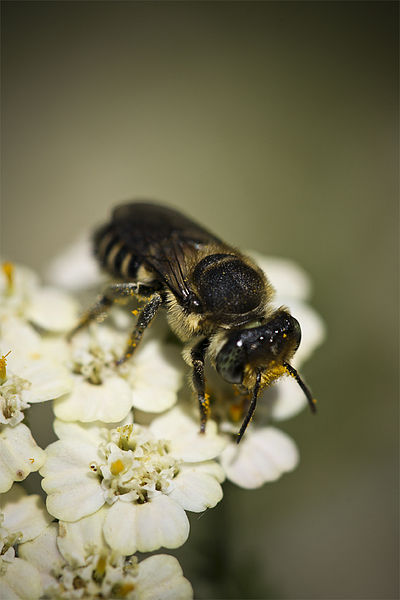Back to August 2015 Newsletter
The Pollinator Fedge

Kim Fellows
At one such presentation, at the Salvation Army Hope and Unity Community Garden, gardeners were interested in learning some tactics to control populations of cucumber beetle, potato beetle and flea beetle. One control strategy is attracting predators such as braconid wasps, tachinid flies, ladybugs, soldier beetles, lacewings and assassin bugs through the use of plants such as umbels (caraway, fennel, cilantro/coriander and Queen Anne's Lace). In most cases, the predator larval stage feeds on the pest, while the predator adults feed on nectar and pollen, so some species may even be important pollinators. So-called weeds such as Canada Thistle even have their place in a garden. The bristles of the thistle help protect the eggs and larvae of ladybugs, and one ladybug larva can eat up to 200-300 aphids per day.
As I mulled over these ideas, it occurred to me that community gardens generally remain barren for up to 7 months a year, usually cleared by November and replanted in late May. Many community gardens prohibit perennials, and certainly very few gardeners would consider growing a plant such as Canada Thistle! Community gardens are also affected when pollinators are scarce, and this happens particularly when they are located in places, such as vacant lots or mowed fields, that lack suitable habitat for native pollinating insects. Of our native bees, 70% are ground nesters, while the other 30% are cavity-dwellers, making their homes in stems of perennial native plants and rotted wood, such as raspberry canes, for example. Pollinators also need a continuous bloom of forage (pollen and nectar from blooming plants) from early spring to late autumn.
This led to the idea of the ‘Pollinator Fedge.’ A fedge is a fence-hedge, and the Pollinator Fedge is a living fence grown around the periphery of a community garden. The Pollinator Fedge provides year-round food and habitat for pollinating insects, with the added value of including food plants that humans enjoy too. A pollinator fedge strives to mimic the natural ecosystem on a smaller scale, and is composed of mainly native, perennial, fruit- and nut-bearing trees and shrubs, perennial wildflowers, herbs, grasses, ground covers and vines. Thorny shrubs and trees, such as sea buckthorn, buffaloberry and hawthorn should grow into an impenetrable barrier in about 5 years.
Pollinator Fedges have a number of benefits:
- They exclude deer, rabbits and other garden predators.
- They provide continuous habitat and forage for pollinators and other beneficial insects to thrive.
- They increase the productivity and quality of the organic garden produce.
- They provide some shade, ideal for growing lettuces and other cool-weather crops.
- They act as a shelterbelt from the wind and help prevent topsoil erosion.
- Certain plants sequester carbon (bluestem grasses) and fix atmospheric nitrogen (legumes).
- Perennial shrubs have thick and often deep root masses that retain water in soils.
- They demarcate the garden in a pleasing, colourful, natural way (as opposed to the orange snow fence currently surrounding the Hope and Unity garden).
For Canadians who are aware of the plight of pollinators, Pollinator Fedges serve as positive ways to take action to help nurture our native bees and other insects. One of the best things we can do for bees is to plant for them – in a continuous succession of blooms from spring to fall, to nourish them with the pollen and nectar that comprises their food sources. Using native plants that have co-evolved with native pollinators also makes a lot of sustainable sense.
Pollinator Fedges are a new way to solve urban agriculture problems. The fedge increases floral and faunal biodiversity, providing ways for our beleaguered native pollinators to thrive. By creating a sustainable ecosystem for pollinators and other beneficial insects, the fedge provides natural pollination services and biological control of pests, and a source of food grown without chemicals.
Watch out for future issues of this e-bulletin, when I will delve into the implementation of our first Pollinator Fedge.
**
Kim Fellows is coordinator of Pollination Canada.
Photo: A tiny native bee on yarrow flowers. aussiegall CC BY 2.0.
Not yet a member?
An annual membership to Seeds of Diversity gives you access to our seed exchange, seed grow-out programs, and our online news.

We depend on donations to do our work.

Thank you for your support!
